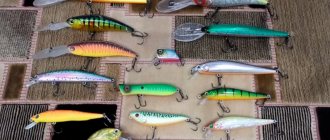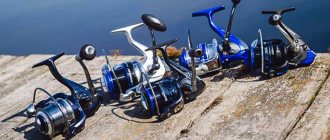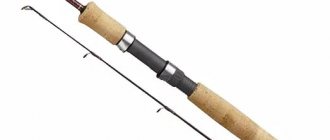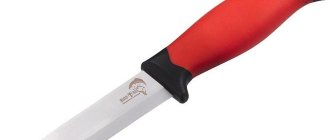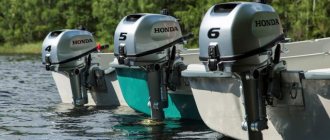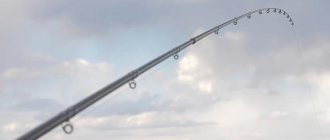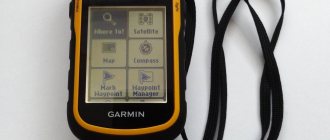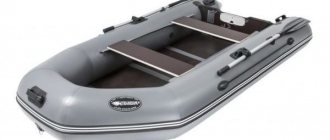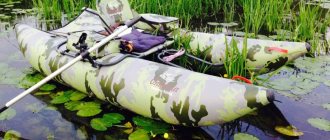Wobbler - This is the most popular and effective bait for asp. It allows you to successfully catch even the largest fish, is excellent for long casts, shows excellent game, and most importantly, modern models that have been produced recently can easily adapt to any fishing conditions.
Criterias of choice
When choosing a wobbler for asp, you should definitely consider a number of points:
Depending on the time of year
In spring:
- The size should be small, about 30 millimeters.
- Color: golden , greenish, red, silvery-yellow. At this time of year, the main thing is to choose brighter, but at the same time close to natural colors.
- The hook is as sharp as possible, preferably double.
- The movement is active.
- The depth is small.
- Select one with the greatest amplitude of tail rotation.
In summer:
- The size should be on average 40 - 50 millimeters.
- The best colors are brown, green and gold. It is better to try multi-colored models.
- The hook is sharp, double or triple.
- The movement is active.
- With the longest cast.
- Immersion up to 1.5 meters.
- With a large rotation amplitude.
Autumn:
- The size is larger , from 9 centimeters.
- The color is golden-red (ideal for winter), brown, black. It is better to take the most natural colors possible.
- The hook is more elongated, better single.
- Flow resistant.
- Movement is smoother.
In winter:
- size from 45 to 50 millimeters.
- colors .
- The hook is extended, can be single or double.
- Resistant even to strong currents.
- The movement is active.
Depending on the place of fishing
At a depth:
- average size
- The ideal colors are considered green and silver.
- The hook is elongated, it is better to have 2 of them.
- The movement is active.
- Models must be sinking.
- The amplitude of rotation of the tail is large.
On the surface of the reservoir:
- The size is small from 3 to 4 centimeters.
- The best colors are red, green, gold, silver, brown.
- Double or single hook
- The movement is smooth.
- Floating models.
In case of strong current:
- size from 9 centimeters.
- Heavy in weight.
- Colors close to natural, for example, silver.
- The hook is as strong as possible, sharp, preferably a triple hook and more than one on the bait.
- The movement is active.
- The game is stable.
In weak currents:
- average size
- Light in weight.
- The color can be any, but a combination is better, for example, gold and black or green and silver.
- The hook is sharp, single, double or triple is suitable.
- The movement is active or smooth.
If the bottom is sandy:
- Size from 5-6 centimeters.
- Medium weight.
- The color is as natural as possible, for example, silver or brown.
- Double or triple hook
- The movement is active.
If the bottom is muddy:
- average size
- Heavy in weight.
- The color is as bright as possible, for example, red, orange, yellow.
- The hook is very strong, elongated, preferably double or triple.
- The movement is active.
Where and how to catch
Walkers, as well as asp walkers, which are easy to confuse, are most effective in calm, windless weather with a weak current. The light weight of the bait will not allow you to cast it accurately and far even in not very strong winds. Well, in a strong current, the action of the bait will become chaotic, nondescript and completely unattractive to fish.
Fishing begins with determining the place where the asp is hunting at that moment. At this moment, the predator is less careful, but you still shouldn’t approach or swim close. And the walker on the asp helps a lot in this aspect. This bait, unlike, for example, a pilker, is capable of luring an asp from a fairly long distance.
The wiring method is jerking. It ensures, on the one hand, the slow movement of the bait along the surface, and on the other, constant trembling and bouncing. This is achieved by slightly twitching the spinning rod, the tip of which must be kept no higher than half a meter from the surface of the water. The angle between the rod and line should be 90 degrees.
The asp attacks the wolfer exactly in the middle
After casting to the desired point, it is recommended to wait a little, leaving the bait in one place. You should start wiring after the asp strikes nearby.
After the hook and the first strong resistance, which usually lasts from 10 to 15 seconds, the asp usually relaxes. But the fisherman should not follow his example. You need to fish carefully, and under no circumstances allow the fishing line to become slack. The fish can strike at any moment, and the power of a trophy asp allows it to break even strong braided cords.
Catching a silvery, beautiful and powerful asp on a warm sunny day is not difficult. And even if in terms of its culinary features it is far from being in first place, there will be plenty of excitement, adrenaline and pleasure.
This bait is good for hunting the main predators of our region: pike, perch, asp and pike perch. When fishing with it, the catches, of course, are dominated by the toothy beauty. This is explained by the fact that pike are very fond of areas of the reservoir where a walker is used. She patiently waits for the fry among water lilies and other vegetation, lets him closer and greedily pounces. To the delight of the fisherman, the “prey” of the pike is often a walker.
The perch also gets hooked. So often that you can’t call it an accident. Striped robbers always show interest in artificial baits, in particular the wolf. If you are lucky enough to find a large flock, just have time to cast. Moreover, often the size of the caught perch is identical to the size of the bait itself.
With pike perch and asp, things are more complicated. You can catch pike perch only at night, when it comes out to hunt in shallow water. It’s even rarer for a walker to end up in an asp’s mouth. You can only count on catching this predator when fishing on the rifts.
TOP best wobblers for asp
The best wobblers for asp are:
Nils Master Haka Shallow
Main Feature:
- Is drowning.
- Can be used when trolling.
- Ideal for shallow water fishing.
- You can make long casts.
- Made from ultra-modern materials.
Peculiarities:
- Excellent for fishing from a steep bank. In this matter it is difficult to find analogues for him.
- The dive is slow.
- Easily gets into places where fish gather.
- Large amplitude of movement of the tail section.
- Produced in any type, size, color, etc.
The main advantages are:
- Durable.
- Doesn't touch the bottom.
- Universal for any body of water.
- Great game.
Minuses:
- Not quite suitable for depth
- Relatively high price (compared to other models).
The approximate cost is from 1 thousand rubles and above.
Zip Baits RIGGE 56
Main Feature:
- Suitable for any depth.
- Equipped with a unique reflective system.
- Amplitude is low.
- The game frequency is low.
Peculiarities:
- Equally well suited for every type of reservoir, including strong currents, standing water, depth and others.
- Available in any shape, color, weight, etc.
- You can cast at any distance.
Advantages:
- Universal for any body of water.
- Suitable for any gear.
- Excellent balancing.
- Only modern materials for its manufacture.
- Does not lose its qualities for many years.
Flaws:
- Many anglers report a little action.
The average cost is 700 rubles and above.
Rapala Husky Jerk
Characteristic:
- for production .
- Large tail amplitude.
- Doesn't come to the surface.
- Universal for any wiring.
Peculiarities:
- Fits perfectly on the water.
- Has a great game.
- Retains all properties regardless of time of use.
- Available in any size, shape, color.
Pros:
- You can stop on the spot.
- Universal for any body of water.
- It adapts to any current, even a very strong one.
- Perfect for fishing using any technique.
Minuses:
- More suitable for fishing with spinning or trolling, but use for other gear is also possible.
- Often attracts the attention of small fish.
The cost on average is 500 rubles and above.
Salmo Thrill
Main Feature:
- Relatively heavy weight.
- are used for manufacturing.
- Each model is designed specifically for asp.
- The suitable depth for it is from 0.5 to 1 meter.
Peculiarities:
- Suitable for any body of water.
- Ideal for strong currents.
- Good game.
Advantages:
- Often attracts the attention of large fish.
- Ideal for fast wiring.
- Excellent for long casting.
- You can fish even from steep and steep banks.
- Excellent for shallow water.
- Low price.
Minuses:
- Not a very suitable option for slow wiring
- Not suitable for depths greater than 1 meter.
The average cost is 250 rubles and above.
Zip Baits Orbit 65 SP Slider
Main Feature:
- The depth of penetration is on average up to 1.5 meters.
- Manufactured using the latest technologies.
- Applicable for any reservoirs.
- They have improved gliding due to their special streamlined shape.
Peculiarities:
- Equipped with a balancing system.
- You can control the location of the bait in the pond.
- Increased casting distance.
- Buoyancy is neutral.
Advantages:
- Has additional weighting material.
- The game is very active.
- Any wiring can be done
- Suitable for all gear.
Minuses:
- In addition to the asp , it attracts the attention of other fish, including very small ones.
- Relatively high price.
The average cost is 850 rubles and above.
Rapala Shad Rap
Main Feature:
- They are manufactured only using the latest technologies, using the latest materials.
- Excellent for asp fishing.
- Available in different sizes, types, shapes, colors (more than 30 colors) and more.
- Universal for any casting.
- Balsamic body.
- Reflective coating.
Peculiarities:
- developing each model for many years.
- Any wiring can be done
- The game is active.
- Depth up to 0.5 meters.
- Excellent flight characteristics.
Advantages:
- bite well .
- A waddling game.
- Universal for all types of reservoirs.
- You can make any casts, including long ones.
Minuses:
- Over time, the coating may become more faded or peel off in places.
Cost from 650 rubles and above.
Yo Zuri L Minnow 44
Main Feature:
- Is drowning.
- Available in 3 sizes.
- Made from the latest materials.
- Depth up to 1 meter.
- Refers to fast-sinking.
Peculiarities:
- Universal for any current, including standing water.
- Great game.
- The amplitude of oscillations is large.
Advantages:
- Suitable for every type of reservoir.
- Ability to perform any wiring.
- Low cost.
- Holds the current well.
Minuses:
- Sometimes, especially after long-term use, there is a loss of brightness.
- Some anglers note that the hooks are not sharp enough.
The average cost is 400 rubles and above.
Hornet S
Main Feature:
- They are made in different models: floating, sinking, diving.
- The materials meet the latest requirements.
- Extended deepening blade.
- Universal for long casting.
- The fastening ring is shifted to the middle.
- Weight on average from 1 to 45 grams.
Peculiarities:
- The game is aggressive.
- The dive is fast.
- Depth up to one meter.
- Excellent flight characteristics.
Advantages:
- Any fish bites well , including large fish.
- Suitable for all types of reservoirs.
- You can make long casts.
- Copes well even with strong currents.
- Available in any shape and color.
- Suitable for all gear.
- Low cost (compared to other manufacturers)
Minuses:
- Sometimes wetting occurs.
- Over time, colors may become duller.
The average cost is 250 rubles and above.
https://www.youtube.com/watch?v=sKxJfANnG_k
Pike on wolfer. Fishing for pike in June
Fish, as you know, can feed in different water layers. Most often you can count on a catch near the bottom, less often in the depths. However, there are also cases when fish bite from the surface. In such cases, completely different baits are used, designed specifically for such fishing. They practically do not go deep.
Today the market is literally replete with equipment of this kind. There are plenty of varieties of such baits. This is a catchy wolfer, and a voluminous popper, and a jerky, with which they fish mainly for pike, as well as a crawler, a mouse, etc. It is difficult to say where and who was the first to fish with such baits, but they have gained popularity among fishermen North American continent.
These nozzles are used in difficult places where there are a lot of snags and aquatic vegetation. In such areas, conventional baits are not suitable, since most of the deep-water varieties of bait remain there. But it is precisely such places that attract pike, a predator that many fishermen hunt. They are its main habitat; here it hides in ambush in search of food.
Many novice fishermen who fish with such baits make the mistake of premature hooking. Predatory inhabitants of reservoirs, in particular pike, love to create splashes and whirlpools around the wolf, but this does not mean that it has already swallowed the hook. Therefore, you need to hook only when a certain load is felt at the end of the rod. In this case, it is worth preparing in advance: for this you need to slightly tilt the tip of the spinning rod towards the water.
Volker
The action of this surface bait resembles zigzags. Currently, there are a huge number of such baits on the market, but the walker is always particularly popular among fishermen. This bulky floating bait glides across the surface when jerked. She goes one way or the other.
The wiring that is carried out with it is jokingly called by fishermen “walking the dog.” Perch and asp readily bite on it, but the most common way to catch pike is with a walker. At the same time, the fisherman, as evidenced by reviews, needs to have good twitching fishing skills. Although the walker models sold today look almost the same, each of them has its own game.
The catchy performance of this bait is possible due to the structure of its body. Walker has a narrow tail and nose. Because of this, it does not wag its tail, like ordinary wobblers, but makes lateral “jumps” during jerks of the rod. In addition, the bow of the walker is somewhat sloping at the bottom. As a result, when playing, you get an “anti-blade” that pushes the bait out of the water.
Varieties
There are mainly two types of this surface bait. Point fishers are precision wolves that fish small areas of water bodies. Another variety - locals - can comb fairly large water areas of reservoirs. The point-use Volker is much smaller than its counterpart. And although you won’t be able to retrieve it quickly, this bait has excellent play on the surface.
Another thing is local fish, with which it is very inconvenient to fish small areas because of their too large scope and poor controllability over short distances. The element of this surface bait is large lakes and open seas. This is where professionals use such wolves when fishing for predatory fish.
Rating
The top sellers are Deps Radscale and ZipBaits Irony baits. These best pike wolves have excellent potential in the right hands. They are easy to use and accessible even to beginners. The prey they catch is most often medium to large in size.
No less popular, according to experienced fishermen, is a surface bait such as Yo-Zuri (Banana Boat). It is no longer produced, but those who have it in their equipment catch almost any predatory fish with it. This bait was produced in three sizes - 7.5, 10 and 11 centimeters.
Ten-centimeter wolves of the Pontoon Loco Perro 21 brand work well even in small waves. The main trophy for them is pike, although some also successfully catch perch and asp using this bait.
The top five in the ranking also includes one of the catchable wolfers, Owner C'ultiva. This bait is something of a legend. It is easy to put into operation, equipped with the sharpest hooks and has high quality workmanship.
This type of fishing has recently become increasingly popular among domestic lovers of quiet hunting. And pike are especially good at catching this way. In June, a fisherman needs to work hard on a spinning rod with a walker or with another attachment to get an excellent catch or pull out a trophy specimen. This bait, when retrieved in the style of twitching the tip of the rod or intermittent reeling on the surface of the reservoir, wobbles from side to side, so to speak, strolls.
For pike, such wolfer movements are associated with throwing of a wounded or sick fish, which cannot go to depth and is therefore easy prey. For any predator, such movements are a signal that it can be picked up. Pike is no exception. In June, spinning fishing with this bait can be effective primarily due to the fact that the wolfer’s movements “turn on” the prey so much that it may not be able to miss it. And even if the bait goes further, the predator reaches out and attacks.
The pace of the retrieve when fishing for pike on a walker should be slow. Still, this toothy prey loves to play slowly. But the pauses between windings need to be longer.
During the retrieve, the wolf, sliding sideways, jumps out of the water with its nose, then dives, and the bait swings again while paused. For many walkers, at this moment the tail goes down, continuing to dangle in a vertical position and playing with the rear tee, equipped with feathers or synthetic trim.
Seasonality
Pike on a walker can be caught on rifts and wide reaches. Some people also use this bait on narrow rivers, moving it along the edges of the grass. Fishing is especially effective in June. Pike with this equipment should be hunted in shallow bays where the amount of clean water is minimal. This kind of fishing is more typical for summer. In autumn, pike react to a walker much worse, which is why this bait is used more to lure prey out of grass thickets.
If a predator has a poor appetite, then the color of this bait should be as close as possible to the color of its food fish - perch, roach, crucian carp or gudgeon.
Fishing for pike in June is somewhat difficult. During this period, production can be quite capricious. Therefore, in order to achieve success, even an experienced fisherman should stock up on considerable patience. In addition, he has to experiment periodically, changing baits - spoons, wobblers or live bait.
It also happens: Unusual ways of fishing
Sometimes you need to spend a long time exploring places where pike are supposed to be located. At this time, according to many experienced fishermen, the wolfer should be fished in quiet pools or holes, at the bottom of which there are several underwater springs. You should not ignore gullies with shallow depths, as well as piles or bridge supports.
In summer, pike react to the wolf with the most active bite. This is especially noticeable in warm and windy weather. At the same time, when moving across a body of water on a boat or other watercraft, you need to take into account one feature: when drifting on the windward side, you need to throw the bait so that, when it flies, it ends up in the right place.
Tackle
Catching pike with surface wolves requires some special equipment. Particular attention should be paid to the spinning rod and reel. The rod must have a super fast action. This is explained by the fact that wolf fishing involves a large number of jerks, and such manipulations can only be performed with a fast spinning rod. The reel should be selected with a small gear ratio, for example 4:7:1.
The spool size must correspond to the parameter 2000-2500. It is better to take a braided fishing line with a cross-section of 0.15-0.2 millimeters. This option better conveys movements to the walker; in addition, this thickness is more reliable during the difficult process of fishing.
Experts do not recommend tying the bait to a leash made of fishing line. For this, it is best to use steel or tungsten analogues, which will definitely be too tough for even such a predator as a pike.
Features of catching asp using wobblers
The main features of catching asp using wobblers are:
- Choose the most durable fishing rod.
- The best rod length is considered to be from 3 to 3.5 meters.
- The reel must have a large spool.
- It is better to choose inertia-free reel models. The ideal size is 2500.
- The fishing line is strong with a small cross-section and should withstand up to 10 kilograms. The ideal size is from 0.14 to 0.16 millimeters.
- The need to cast as far as possible.
- The wiring should be smooth with periodic jerks.
- After casting, you need to put the reel on the friction brake.
- Make the hook very quickly. Asp is a fairly strong fish; as a rule, it bites suddenly and sharply. The risk that it could break is quite large.
Classification of wobblers by design: help from the editors of Zuzako
Before opening catalogs and looking for the right wobbler, you need to decide on the type of tackle you will use. There are quite a lot of them, so making the right choice will be difficult. Various videos and reviews in Russian, as well as help from our editorial staff, will definitely help you in this matter.
Types of wobblers:
Minnow. This type of gear is the most popular among fishermen. They have a simple design and shape resembles a popular hunting object among predators - bleak and verkhovka. Minnows are long and short in height. Other features include a cigar-shaped and slightly convex body.
Fat. Wobblers of this type have a teardrop shape. In most cases, they are quite large and heavy. Such gear is ideal for beginners and professionals, but only works effectively at shallow depths.
Shad. This catchy wobbler resembles a rudd, roach or small perch in appearance. Strong similarity to the listed fish species increases the chances of success. Such gear is best used by beginning spinners.
Crank. Wobblers of this type are something between fat and shad. They are not very active in the water, imitating the actions of a wounded fish. Cranks are suitable for beginner fishermen, as they do not require any complex wiring.
Stickbait. Tackle of this type is characterized by heavy weight, which allows you to make long casts. In addition, they do not have a blade, which significantly improves aerodynamics. Most often I use stickbaits for catching cautious fish (for example, asp).
Volker. This bait is a copy of a stickbait. The only difference is that when guiding, the walker moves along the water surface, and its analogue dives to a depth of 5 cm.
Popper. This type of wobbler is used only by professionals. This is due to the fact that only with proper wiring will it create a lot of splashes and make characteristic sounds that attract predators. Poppers have a cup-shaped indentation at the front that makes them easy to distinguish from other types of baits.
Crowler. This type of gear is equipped with a blade located perpendicular to the longitudinal axis of the body. Thanks to this design, it reflects a lot of light, which attracts a large number of predators.
Rattlin. This type is distinguished by having a flat body and a capsule with noise elements
Another important feature of the rattlin is the presence of a ring on the back for attaching to a leash or fishing line.
Jerkbait. Wobblers of this type are ideal for jerking.
Most often they are large in size and weight, which allows for long casts. Moreover, such gear requires a powerful rod and an appropriate reel.
Darter. This bait is used for catching sea fish. It has a beveled front part, which creates chaotic play and attracts the attention of different predators.
Swimbait. Such a wobbler is a structure of several moving elements made of some soft material. During wiring, it is as close as possible to a real fish, which a nearby predator will definitely want to catch.
On AliExpress you can find hundreds of types of cheap wobblers, spinners and other similar gear, which are a high-quality analogue of expensive Russian and European-made baits. Careful reading of our article will help you choose the best models from them. It contains reviews of the best wobblers from China that will turn your fishing into an exciting and successful experience.
Blitz tips
- It is better to take several different models of bait for fishing ; if no bites are observed for a long time, then replace the wobbler with another one.
- Constantly change your wiring technique.
- For fishing in rocky areas, choose heavier models with active play.
- Don’t save money ; better quality and more expensive wobblers from trusted manufacturers will last for many years.
- When choosing wobblers, pay special attention to the hooks; they must be very strong and sharp.
- Choose colors that are closest to natural, with the exception of fishing in muddy water.
- It is better to purchase models with a noise effect; it has been noted that they are able to attract asps even at a considerable distance.
Tactics and techniques for catching pike on a walker
First, let's figure out what a walker is? There is no special definition for lures of this type, but I will try to formulate it. And so: a wolfer is a surface bait, the game of which resembles zigzags. Currently, the market is replete with a number of surface baits, and walkers deserve special honor and respect.
There are two types of walkers: point-based ones, that is, a bait with which a small area of a reservoir is caught, and local ones, with the help of which large areas of water are combed. Point-use walkers are significantly smaller than local walkers. It’s not possible to conduct quickly with them, but the vulgar, impudent game on the surface is for them.
I’ve been fishing with this type of bait for a very long time and I realized this: besides wolves, there are no better surface baits! Crollers and poppers are already a thing of the past, the time has come for walkers.
Another biggest advantage of wolves is that such bait is very difficult to tear off, and even if such a situation happens to you, your bait will be on the surface and you can easily swim after it. A volker can be lost due to shooting, but by and large, volkers are stored for years and nothing happens to them.
Let's move on from theory to practice. We have a large supply of walkers and a spinning rod in our hands. Stop. Here are a few words about the spinning rod and reel. Your stick should have a super-fast action, since you already understood that the walker requires jerking, and we can only perform such manipulation with a fast rod. The reel should be selected with a small gear ratio, for example: 4:7:1.
Now let's look at the wiring technique. As was previously said, each bait has its own approach. If you have mastered one wolf, then your path does not end there, we simply move on to finding the key to another bait. By and large, if you know the basics, then you don’t have to come up with something else, you just adapt to the prevailing conditions.
Arriving at a body of water, we immediately detect a predator, of course if it is active. You can tell that pike are active by numerous splashes on the surface of the reservoir. To fish a large area of water, set up a localizer and go into battle! If the activity of the predator leaves much to be desired, then the wiring can be brightened up with pauses. When activity is at its best, you can do without them.
In summer, pike stand in the thickets, namely in the windows of the water tree. We throw dots into such places and I assure you the effect is amazing.
Toothed activity at zero is not a problem; the walker can be lubricated with an attractant. The attractant allows you to activate the bite, and you will always have a catch.
There is one small problem with walkers. The fish come off very often, but this is nothing compared to the sensations our dog gives us!
When fishing for pike, remember one very good rule: To catch a predator, be more cold-blooded than he is!
WHAT IS WALKER?
In order to avoid confusion, let's define the terms. In the previous article, which talked about walkers, we called these lures jerk baits, or more precisely jerk baits. In essence, this is correct, but not very specific, since the class of baits for jerk fishing, or in other words, jerking, is very wide, and when they are mentioned, the reader may have false associations with large jerk baits intended for catching pikes and muskies (photo 3).
Photo 3
Volker Split'n Image from EXCALIBUR
The term “bladeless wobbler” is also not the most appropriate, since wobblers are traditionally called active baits.
Which name is more suitable for the 2000 lures from RAT-L-TRAP. The term "stick bait" found in the literature is even worse. Firstly, in addition to the baits we are interested in, some wobblers are called this way (for example, the “Bang-O-Lure” stick bait from BAGLEY'S) and even soft baits shaped like a stick. Secondly, the stick-shaped shape is not such a decisive feature of these lures. For example, the interesting model “Spit'n Image” from EXCALIBUR is clearly a shad (herring) in shape.
Many catalogs classify our subject of interest as "Hard Bait/Top Water". But this does not allow us to distinguish it from other baits gurgling and slapping on the surface. There is also the following description: “Hard Bait/Surface/Side-to-Side”. Much more accurate, but too cumbersome.
A notable feature of our lure is its characteristic movement through the water, called “Walk'n the Dog”. Remember what yaw movements in different directions a dog makes when dragging its owner on a leash). Therefore, we consider “Walker” to be the most appropriate term.
And although the movement of famous American lures for catching pike often differs only in quantitative characteristics, these super-heavy analogues of walkers have already been given the name “jerk bait” in practice, so we hope there will be no confusion.
Distinctive external features of the walker: almost teardrop-shaped nose, absence of blades and propellers, small size. The buoyancy is positive, and with a loaded tail section, which provides good (better than a wobbler) flight qualities and, most importantly, a typical game with proper wiring. We prefer wolves with a length of 7-8 cm and a weight of 7-8 g. We consider the value of coloring in comparison with the dynamic properties of this bait and the quality of the wiring to be insignificant. We use walkers from YO-ZURI, DUEL, OWNER. There are also successful models from lesser-known companies.
The scope of application of the walker is not at all limited to asp fishing. This bait showed excellent performance when fishing for pike perch in shallow water at night. When catching perch, it is not inferior to the popper, although the latter, it seems, was originally designed for catching fish from the order Perciformes and, of course, knows how to “wind up” them.
It should be said that the walker, like the wobbler and popper, is not intended for widespread use in summer asp fishing from the shore of a reservoir or a river such as the Dnieper, to the middle of which, as is known, only “a rare bird reaches.” On a large river, a schooling asp in the summer goes out onto the expanses of wide reaches or onto spits cut off by oxbow lakes from the main bank, which, by the way, cannot be reached without a boat anyway.
But when fishing from a boat, the wolfer is beyond praise. At first, we even had the illusion that the long-awaited super bait had been found.
N.H. At the end of June, having spent the whole day unsuccessfully searching for an asp, I found it on the way back not far from our base. First, from a distance, I saw a boat in a characteristic place, and then the long-awaited “battle”: the asp attacked along the entire reach in three combat columns. After a roundabout maneuver, I anchored, keeping my distance from my competitors, who seemed to be tired of unsuccessful attempts to seduce the predator with their castmasters.
Asp took the walker on the second or third retrieve. The quick success and lack of time (it was already getting dark) forced me to speed up the game, and, of course, my neighbors noticed this. Imagine their amazement when, when landing the next, two-kilogram asp, which after a couple of casts was violently attacked by the wolfer, I, on the contrary, calmly switched the rod to the other hand, took out a “soap box” from my backpack and began to catch the most opportune moment for shooting.
I photographed the third asp, brought it out, demonstratively released it and left, despite the incessant “fight”. When I raised the anchor, the competitors turned away not only from me, but, it seems, from each other.
Of course, on my part it was just a minor show off - I understood that with such lighting, with such a lens, nothing worthwhile would come of it. Perhaps even this story would not have deserved the attention of readers if it had not been for its continuation the next day. In the same place, in the same weather and with the same asp fight, in full view of yesterday’s witnesses of my “professionalism,” I did not take a single fish, although I “worked” from the moment the evening water was supplied until dark.
Of course, we had encountered such fastidiousness of the asp before, but I had a walker in my hands, in whose reliability I had already begun to believe! But, fortunately, there are no fail-safe baits. At least if you are hunting asp.
WALKER FISHING TECHNIQUE
When fishing with a wolf, the angler holds the tip of the rod at a distance of approximately 0.5-0.7 m from the surface of the water (at the initial stage of fishing); in this case, the rod and line should form approximately a right angle. Oscillations of the rod tip in the horizontal plane should have a small amplitude (15-25 cm) and a high frequency (2-4 Hz, depending on the walker model).
Trajectory and parameters of the walker's movement:
H - span (15-20 cm)
h - step (10-25 cm)
V is the wiring speed, which is equal to 0.5 hf, where f is the jerking frequency.
This is the difficulty of synchronizing the actions of the two hands: high, sometimes the maximum possible intensity of work with the hand that makes jerks with the rod, and slow (only in order to promptly pick up the slack in the fishing line!) rotation of the reel handle with the other hand.
Since vibrations are created primarily by the hand, to increase leverage it is convenient to place your index finger on the extension of the rod handle.
The walker must be in motion all the time, and the jerking pace accelerates or slows down depending on the situation in the bait area. When fishing this way, the spinner is like a conductor: the main thing here is to set the rhythm, and the bait will do the rest.
In conversations with Kyiv spinning anglers who had already tested such baits, it turned out that many of them, due to errors in technology, were unable to appreciate the new product. One such common mistake is that the angler, when jerking, lifts the tip of the rod upward, thereby lifting the line from the water. In fact, the walker plays better (more naturally) if the vector of the force applied to him “lies” on the surface of the water. This happens when the bait is relatively far away and the line sticks to the water. As the bait approaches the boat, the angler should lower the rod tip closer to the surface. Doing this while sitting is not always convenient. But on the other hand, you can witness a desperate attack under the very board.
An interesting tactic for using a walker is as follows. The fisherman throws the bait to the point where the asp periodically strikes, and... waits. Jerking begins only after the next blow of the asp in this place. Additional casting of the bait downstream is usually not required - on a boat you can almost always get within casting distance.
Walker "Arms Pencil" from YO-ZURI
Walker "Zip'n Ziggy" by OWNER
Last year several large “residential” asps were caught using this technique. In essence, this is a modification of fishing with a preliminary calculation of casting time, in the reliability of stories about the practical application of which, to be honest, we have little faith. When fishing with holding time after casting, the obvious advantage of a walker compared to a spinner is that it does not sink in standby mode, and compared to a wobbler, it has no unwanted vibrations before the start of the cast, even in strong currents.
This technique is good specifically when hunting large sedentary asp under bushes, near obstacles, etc. It is not very suitable for catching an asp loitering along the current (since the boat in this case should be installed on the line of passage of the flock, but this is far from an ideal place) - here the tactic of splash casting is much more reliable.
When catching a predator that periodically attacks from ambush, placing the boat 20-25 m higher from the attack site usually does not disturb the rhythm of its hunt. When catching such asp, a walker has one more advantage: it expands the possibilities of safe wiring in “strong” places. Well, if the owner of such a place, attracted from the depths, takes the bait, then God willing... The game is worth the candle!
True, there is an opinion that it is the large asp that is especially careful. To confirm this, we can recall a well-known pattern: with age, a fish’s visual acuity increases due to an increase in the size of the lens. But we have long noticed that large asp usually do not react to the boat. Perhaps he knows well what can be done in this case and what cannot be done. But he is not yet familiar with the wolfer.
By the way, fly fishermen have been catching asp (and more capricious fish) for a long time, although the casting range with a fly rod is usually no higher than with a light spinning rod, and they fish in clear water. And, judging by the photos in magazines, they are not particularly concerned with camouflage...
We prefer to fish with a wolfer using a low-profile multiplier, and with the handle positioned on the left. It is easier to jerk with your right hand, and this is another plus in favor of a left-handed reel. The advantages of the multiplier are its durability in jerking mode and the speed of preparation for casting. In addition, the traditional disadvantage of the multiplier - the difficulty of casting light baits against the wind - is compensated by one remarkable property of the walker: it is effective when guiding at different angles to the current. We have repeatedly seen this in practice - it is only important to select the appropriate frequency of jerks and winding speed. To be fair, it should be noted that some difficulties arise when guiding against a very strong jet.
We wind 10-15 pound line onto the baitcaster spool. When jerking with a spinning reel, in order to reduce the load on its mechanism, we use fishing line. In this case, the jerks are somewhat softer, although we did not observe much difference in the results.
It is believed that a rod for jerking should be short, but for effective casting of light baits it is better that it be 2.7-3 m. To optimize vibrations, the action of the rod and its length must be coordinated, therefore, in our opinion, not a short, fast rod is advisable rod, nor a long “noodle”.
Walkers are attached to the fishing line in the same way as wobblers. I would like to return once again to the topic of knotless fastening of baits. Being designed for braided cords, the Not-a-Knot bracket is quite applicable in combination with monofilament lines, especially those types that, while possessing fairly high strength characteristics, lose these qualities at the knot.
As for the hooks, it is worth noting that compared to a mini-wobbler, the walker is equipped with more solid tees, and this reduces the number of hooked fish. By the way, unlike the popper, the walker does not have a stabilizing tail tail (although we have experience of successfully modernizing an overly “loose” walker with the help of such tail).
HYPOTHESES, HYPOTHESES...
For a fish that knows nothing about the movements of the rod made during jerking, a walker is the same wobbler, only with a lower frequency and high amplitude. There is, however, one more difference in its game: if the wobbler oscillates with its whole body relative to the center of mass, then the wobbler wags primarily with its front part, and all this happens at the very top with the formation of a powerful surface wave - the so-called “whiskers”.
Some fishermen believe that, ideally, the asp bait should not go along the surface itself, but at least one or two palms lower. Indeed, this is a very typical horizon for an asp, and the walker is located higher when guiding. And yet, no matter what horizon the predator is hunting, the speed of the bait that is comfortable for attack, its characteristic movements and, possibly, “whiskers”* very often do not leave the asp indifferent - he attacks the wolf on the surface. Such attacks on the bait not only excite the blood, they are often the only indicator of the presence of an asp on the riffle.
By the way, in one of the latest publications about the asp, the idea was expressed that he checks the object of attack with head blows. We don't think that's true. Sometimes the asp attacks up to 3-4 times per retrieve and eventually lands on the tee. Why does he need such checks?
Another fresh theory that replaced the “concussive blows” hypothesis is the “whirlpool” hypothesis. We have never seen our bait “sucked” into such a whirlpool. But we know well at what speed most anglers rotate the reel handle when fishing for asp. With such wiring, their Devons and Castmasters hardly look like stunned and disorientated fish, which the asp supposedly puts into such a state with his blows and whirlpools.
In general, the faster you master fishing with surface lures, the faster you will get rid of such misconceptions.
What kind of bait is a wolfer: provoking or imitating? It has enough of both properties. It seems that he provokes the asp much more than an ordinary top dog. And he imitates it so believably that even terns often make mistakes. This has happened to seagulls before, but now it has become a whole problem.
We have already said that the walker (like the popper) has a very long “radiation” range. On the one hand, this is, of course, good: casting them does not require the same precision and speed of reaction as when fishing with a spoon or wobbler, which even somewhat reduces the sportiness of fishing. But, on the other hand, repeated use of strong stimuli in one place (when catching schooling fish) causes an addictive effect in the predator. This is especially evident in fish with high adaptive abilities. The asp is just such a fish.
The asp cools down very quickly to the annoying chomping of the popper, so adored by the perch: with this bait we have never caught more than one asp at a time on one riffle, and he usually pecked at the very beginning of fishing. This is an example, so to speak, of “short-term” habituation of a predator. According to our assumptions, the dynamics of changes in the asp’s interest in various baits during one fishing trip looks approximately as shown in Fig. 8.
At the beginning of summer, we observed up to 20 or more asp attacks on a wolfer in one place. But over the course of the season, the productivity of its use gradually decreased. The diary entries confirm this. On the same riffles at the end of summer, the asp attacked the wolf only on the first three or four retrieves. Of course, this could be due to various circumstances, but it is possible that here we are already dealing with persistent addiction. If this is the case, then perhaps Walker will only be a hit for a few seasons.
_______________
*V. Andreev suggested that the predator first detects the “whiskers”, and then their source. It is difficult to say which sensory organ of the fish plays a decisive role in this. - Auth.
www.prospinning.ru

